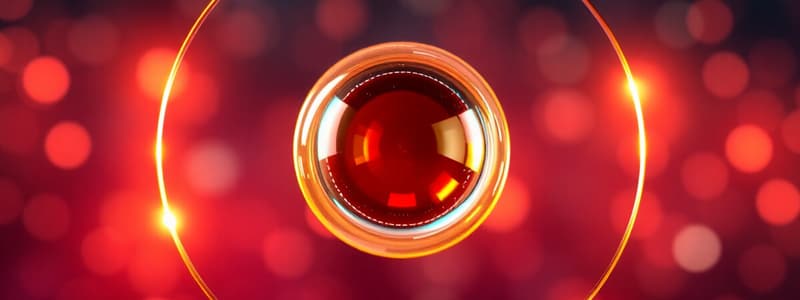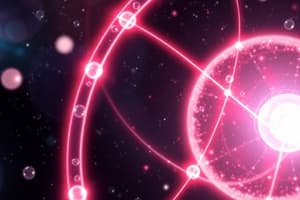Podcast
Questions and Answers
What does the principal quantum number (n) primarily determine?
What does the principal quantum number (n) primarily determine?
- The shape of the orbital.
- The energy of an electron in an orbital. (correct)
- The spin of the electron.
- The direction of orientation in space of the orbital.
A higher value of the principal quantum number (n) indicates a smaller electron energy level where electrons are less likely to be found further from the nucleus.
A higher value of the principal quantum number (n) indicates a smaller electron energy level where electrons are less likely to be found further from the nucleus.
False (B)
What information does the secondary quantum number (l) provide about an electron's orbital?
What information does the secondary quantum number (l) provide about an electron's orbital?
- The shape of the orbital. (correct)
- The energy of the orbital.
- The number of electrons it can hold.
- The direction of the orbital in space.
The secondary quantum number l ranges from 0 to ______.
The secondary quantum number l ranges from 0 to ______.
If the secondary quantum number (l) of an electron is 1, which type of orbital does it occupy?
If the secondary quantum number (l) of an electron is 1, which type of orbital does it occupy?
What does the magnetic quantum number ($m_l$) describe?
What does the magnetic quantum number ($m_l$) describe?
For a 'd' orbital (l = 2), what are the possible values of the magnetic quantum number ($m_l$)?
For a 'd' orbital (l = 2), what are the possible values of the magnetic quantum number ($m_l$)?
The spin quantum number ($m_s$) indicates that an electron can only spin in one direction.
The spin quantum number ($m_s$) indicates that an electron can only spin in one direction.
Match the quantum number with its description:
Match the quantum number with its description:
If an electron has a principal quantum number n = 3, what are the possible values for the secondary quantum number l?
If an electron has a principal quantum number n = 3, what are the possible values for the secondary quantum number l?
If n=3, what are the possible $m_l$ values when $l=1$?
If n=3, what are the possible $m_l$ values when $l=1$?
If two electrons are in the same orbital, they must have the same spin.
If two electrons are in the same orbital, they must have the same spin.
For a given value of l, the number of orientations is equal to ______.
For a given value of l, the number of orientations is equal to ______.
When n = 1, what type of orbital is possible?
When n = 1, what type of orbital is possible?
When n = 2, there are four possible orbitals, which include one 2s orbital and two 2p orbitals.
When n = 2, there are four possible orbitals, which include one 2s orbital and two 2p orbitals.
How many orbitals are possible when n=3?
How many orbitals are possible when n=3?
Describe the shape of the 'p' orbitals.
Describe the shape of the 'p' orbitals.
The number of orbitals present at each energy level is given by ______.
The number of orbitals present at each energy level is given by ______.
Match the energy level with the number of orbitals possible:
Match the energy level with the number of orbitals possible:
What is the key difference between the $p_x$, $p_y$, and $p_z$ orbitals?
What is the key difference between the $p_x$, $p_y$, and $p_z$ orbitals?
Flashcards
Principal Quantum Number (n)
Principal Quantum Number (n)
Identifies the energy of an electron in an orbital. Higher n means larger size and further distance from the nucleus.
Secondary Quantum Number (l)
Secondary Quantum Number (l)
Identifies the shape of the orbital (subshells).
Magnetic Quantum Number (ml)
Magnetic Quantum Number (ml)
Identifies the direction of orientation in space of the orbital.
Spin Quantum Number (ms)
Spin Quantum Number (ms)
Signup and view all the flashcards
ml when l = 0
ml when l = 0
Signup and view all the flashcards
ml when l = 1
ml when l = 1
Signup and view all the flashcards
ml when l = 2
ml when l = 2
Signup and view all the flashcards
Number of Orientations Formula
Number of Orientations Formula
Signup and view all the flashcards
Total Orbitals Formula
Total Orbitals Formula
Signup and view all the flashcards
"s" orbital
"s" orbital
Signup and view all the flashcards
Study Notes
- Quantum numbers describe the properties of atomic orbitals and the electrons within them.
Principal Quantum Number (n)
- Represents the energy level of an electron within an orbital.
- It is a positive whole number (n = 1, 2, 3,...).
- Higher values signify larger energy levels and a greater probability of finding the electron further from the nucleus.
Secondary Quantum Number (l)
- Defines the shape of the orbital and describes energy sublevels or subshells.
- Values range from 0 to n-1.
- l = 0 corresponds to an "s" orbital.
- l = 1 corresponds to a "p" orbital.
- l = 2 corresponds to a "d" orbital.
- l = 3 corresponds to an "f" orbital.
Magnetic Quantum Number (ml)
- Specifies the direction of the orbital in space.
- For a given value of l, ml ranges from -l to +l, including 0.
- When l = 0, m = 0 (one orientation).
- When l = 1, m = -1, 0, +1 (three orientations of "p" orbitals: px, py, pz).
- When l = 2, m = -2, -1, 0, +1, +2 (five orientations of "d" orbitals).
Spin Quantum Number (ms)
- Describes the intrinsic angular momentum of an electron, which is quantized and also referred to as spin.
- Values are either +1/2 (spin up) or -1/2 (spin down), often visualized as clockwise (cw) or counterclockwise (ccw) spin.
- Electrons behave as if they are charged and spinning.
- If two electrons occupy the same orbital, they must have opposite spins.
Orbitals at each energy level
- The number of orbitals present is given by n².
- When n = 1, there is 1 orbital possible (1s orbital), which is spherical.
- When n = 2, there are 4 orbitals possible: one 2s orbital and three 2p orbitals.
- When n = 3, there are 9 orbitals possible: one 3s orbital, three 3p orbitals, and five 3d orbitals.
Studying That Suits You
Use AI to generate personalized quizzes and flashcards to suit your learning preferences.




